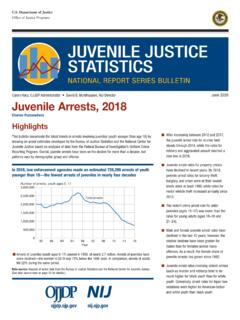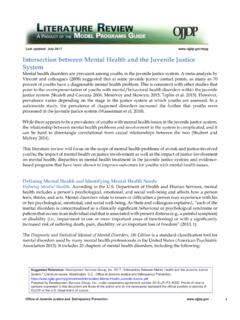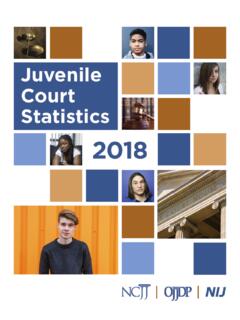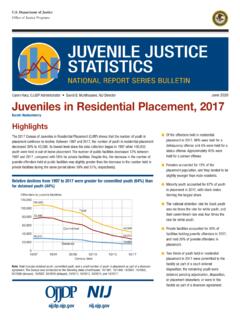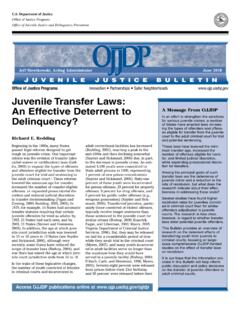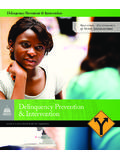Transcription of JUVENILE JUSTICE STATISTICS
1 Department of JUSTICE Office of JUSTICE Programs Chyrl Jones, OJJDP Acting Administrator Jennifer Scherer, NIJ Acting DirectorJUVENILE JUSTICE STATISTICSNATIONAL REPORT SERIES FACT SHEET February 2022 delinquency Cases in JUVENILE Court, 2019 Sarah Hockenberry Counts and trends In 2019, JUVENILE courts in the United States handled 722,600 delinquency cases that involved juveniles charged with criminal law violations, 2% less than the number of cases handled in 2018. From 2005 through 2019, the number of delinquency cases declined 56%, with decreases in all four offense categories: property offense cases (down 65%), public order offense cases (down 59%), drug law violation cases (down 47%), and person offense cases (down 45%).
2 In 2019, person offense cases accounted for the largest proportion (33%) of the delinquency caseload, followed by property offense cases (30%), public order offense cases (24%), and drug offense cases (13%). The decline in JUVENILE court caseloads since the mid-1990s is the most substantial decline since 1960 Number of cases 2,000,000 1,600,000 1,200,000 800,000 400,000 Year Total delinquency 62 65 68 71 74 77 80 83 86 89 92 95 98 01 04 07 10 13 16 19 Between 2005 and 2019, the number of cases handled by JUVENILE courts decreased for all offenses except criminal homicide Percent change Most serious offense Number of cases 2005 2019 5-year 2015 2019 1-year 2018 2019 Total delinquency Person offenses Criminal homicide Rape Robbery Aggravated assault Simple assault Other violent sex offenses Property offenses Burglary Larceny-theft Motor vehicle theft Arson Vandalism Trespassing Stolen property offenses Drug law violations Public order offenses Obstruction of JUSTICE Disorderly conduct Weapons offenses
3 Liquor law violations Nonviolent sex offenses 722,600 56% 17% 2% 237,000 45 2 3 1,100 1 49 10 8,300 24 12 7 18,600 28 1 0 25,700 46 2 1 153,100 45 4 5 7,500 45 1 1 214,500 65 28 4 38,600 61 26 7 89,600 67 38 7 15,300 53 16 3 2,100 71 23 1 35,900 65 17 1 19,500 63 26 4 7,000 66 17 4 101,000 47 12 4 185,100 59 20 5 90,500 58 26 9 48,000 63 17 0 16,400 62 14 1 3,900 73 32 3 11,100 7 9 5 n Although the number of JUVENILE court cases for most offenses decreased in the 5 years between 2015 and 2019, the number involving criminal homicide increased considerably (49%).
4 Notes: Totals include offenses not detailed. Percent change calculations are based on unrounded numbers. 0 2 National Report Series Fact Sheet Gender Nearly three-quarters of the overall delinquency caseload involved males. In 2019, JUVENILE courts handled 522,300 cases involving males, compared with 200,300 cases involving females. Between 2005 and 2019, the relative decline in delinquency cases overall was the same for males and females (down 56% each); however, the decline in property cases was greater for females while the decline in drug cases was greater for males.
5 Percent change 2005 2019 Male FemaleMost serious offense Total delinquency 56% 56% Person 46 43 Property 63 68 Drugs 51 32 Public order 59 60 The female proportion of the delinquency caseload changed little for most offense categories between 2005 and 2019. Female proportion 2005 2019 Most serious offense Total delinquency 28% 28% Person 30 31 Property 28 25 Drugs 20 26 Public order 28 28 Race Forty-three percent of delinquency cases handled in 2019 involved White youth, 35% Black youth, 19% Hispanic youth, 2% American Indian youth (including Alaska Natives), and 1% Asian youth (including Native Hawaiians and Other Pacific Islanders).
6 In 2019, the JUVENILE population consisted of 53% White youth, 15% Black youth, 24% Hispanic youth, 2% American Indian youth, and 6% Asian youth. Race profile of cases, 2019 Most serious offense Race Total delinquency Person Property Drugs Public order Total 100% 100% 100% 100% 100% White 43 41 42 53 41 Black 35 38 38 19 37 Hispanic 19 18 17 24 20 American Indian 2 2 2 2 1 Asian 1 111 1 Note: Detail may not add to totals because of rounding. The racial disproportionality in delinquency cases varied across offense categories. White youth accounted for a larger proportion of drug offense cases (53%) than any of the other general offense categories.
7 In contrast, Black youth were involved in only 19% of drug offense cases, but accounted for larger proportions of person and property offense cases (38% each) and public order offense cases (37%). Hispanic youth were involved in 24% of drug offense cases, accounting for their largest share across offense categories. Asian and American Indian youth accounted for a small proportion of cases across all offense categories. Variations in case processing by race can be examined by looking at the rate at which cases involving different groups of youth proceed from one decision point to the next as they move through the court system.
8 The referral rate (per 1,000 youth at risk of JUVENILE court involvement) for delinquency cases involving Black youth ( ) was about three times the rates for White ( ) and Hispanic ( ) youth. Cases were more likely to be petitioned for formal processing for Black youth (60%) than White (48%) or Hispanic (52%) youth. Once petitioned, cases involving Black youth were less likely to be adjudicated (50%) than cases involving White (53%) and Hispanic (58%) youth, and slightly more likely to be waived to criminal court ( ) than White and Hispanic youth ( and , respectively).
9 Once adjudicated, cases involving Black or Hispanic youth were more likely to result in residential placement (31% each) than cases involving White youth (22%). Conversely, adjudicated cases involving White and Hispanic youth were more likely to result in probation (68% and 65%, respectively) than cases involving Black youth (61%). Age In 2019, juveniles younger than age 16 at the time of referral to court accounted for 54% of all delinquency cases handled. This age group accounted for 61% of person offense cases, 55% of property offense cases, 53% of public order offense cases, and 41% of drug law violation cases.
10 Person offense cases had the largest proportion (12%) of very young juveniles (younger than age 13 at referral), followed by property and public order offense cases (8% each). For drug offense cases, a smaller proportion (3%) involved juveniles younger than age 13. Detention A JUVENILE may be placed in secure detention at various times during case processing. Detention is primarily used for temporary holding while youth await adjudication, disposition, or placement elsewhere. Many states detain youth to ensure the youth s appearance at subsequent hearings, delinquency Estimates The estimates are based on data from nearly 2,500 courts with jurisdiction over 87% of the nation s JUVENILE population (youth age 10 through the upper age of original JUVENILE court jurisdiction in each state) in 2019.
